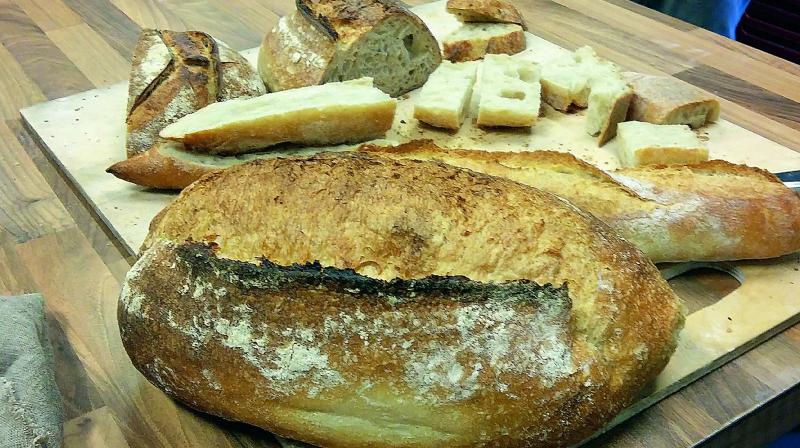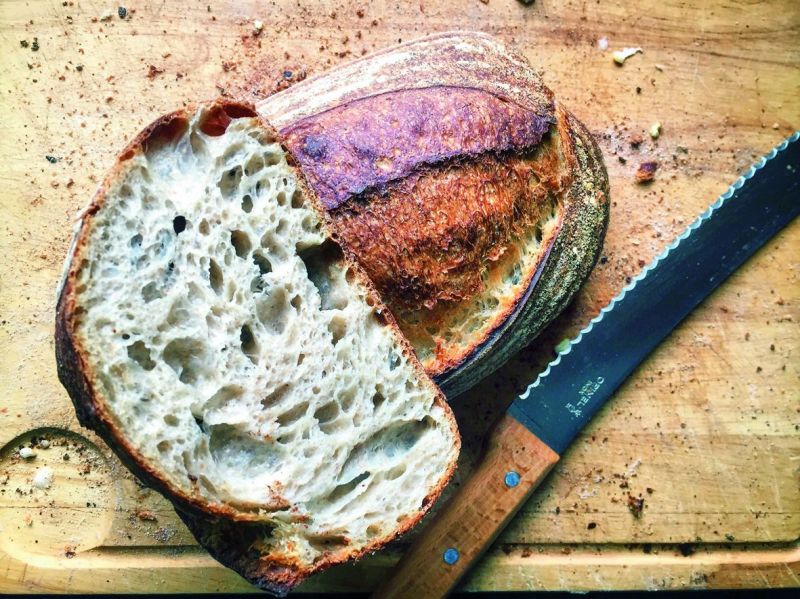Loaf'ty crusts

There’s nothing quite like the aroma of a crusty loaf of bread, baking in the oven. For most of our generation, it brings back memories of cooking with our mothers and grandmothers, where food was homemade, with simple ingredients and a loving touch. Sadly, with commercialisation and busy lives, store-bought bread packed with stabilisers and cheap fats is the order of the day.
UNCOVERING SECRETS FROM MASTER BAKERS
In a quest to revive and revisit the ancient traditions of home baking, I trek across the bakeries of Northern Ireland, renowned for their repertoire of luscious breads made the old-fashioned way, free from additives, enzymes, improvers or anything artificial. Here in the tiny villages of County Down and Belfast, bread making is a passion and national pastime based on a long tradition of authentic recipes and the highest quality ingredients.
Our first stop is the Ursa Minor Bakery, where we meet baker Dara for a Sourdough Bread Making class. A self-taught baker with a passion for local, sustainable, organic ingredients using traditional methods, his simple three-ingredient no-fail method of making bread has won him rave reviews and a loyal fan base. “Most people are intimidated to bake their own bread,” he says. “But all you need are three ingredients — flour, water and salt.” What makes the bread at Ursa Minor so special is yeast elimination.
“We use a starter which is made by fermenting flour and water over a long period of time in place of bakers yeast. The flour and water use the natural occurring bacteria in the air and ferment together. Research is showing that this method of making bread is beneficial for those who suffer from gluten intolerance as due to long fermentation, the gluten develops and starts to break down, which in turn makes it easier to digest. This is a traditional method of making bread that dates back for most of human history since commercial yeast/rising agents were only created approximately 150 years ago.” Dara explains The result is a crusty loaf that has a dense yet delicately sour flavour — sheer heaven!
Sourdough bread has better inherent keeping qualities due to the lactic acid produced by lactobacilli. Unfortunately in India, home baking is only just catching up with the West and our repertoire for bread making is restricted to pedantic dinner rolls and loaf bread! I’m curious to expand my basic bread making skills so I contact, Tracey Jeffery, a film producer-cum-foodie who organises curated food tours to the farms for local producers. On her ‘NI Food Tour’ we sample foods as varied as single estate whiskey to artisan dulse wheaten bread and the famous Irish soda bread — a unique griddle bread first baked in the 1800s in Ireland as well as other specialties like The Belfast Bap (a crusty round bread that originated during the famine) and Veda (a malted bread only available in Northern Ireland).
BREAD MAKING HISTORY
Bread is one of the earliest recorded foods due to the fact that the cultivation of wheat has been an art, practised way before recorded history. Anthropologists believe that hungry hunters stockpiled grain as a storable food source. When it got wet, it sprouted, and they found that if the grain was planted, it yielded more seeds. The first-known bread making attempts were probably in Mesopotamia and Egypt, where people discovered that wheat could be pulverised and made into a paste. Placed on a fire, the paste solidified into flat bread. It wasn’t long before they realised how to make leavened (raised) bread when yeast was introduced to the paste.
The Egyptian contribution as forebears of the bread revolution cannot be over emphasised. They learnt through trial and error to make at least 40 varieties! Bread was so intrinsic in Roman times that the word was a synonym for food. A person’s social status could be discovered by the colour of bread they ate. The darker the bread, the lower the social strata as whiter flours were more expensive. Today, it’s the opposite as darker breads are more sought-after in nutritional value.
NUTRITIONAL FACTS
Inspite of the fact that people around the world depend on bread as a staple food, it has received a lot of bad press as a no-no because it’s perceived as a “high carb” food. Although the wheat used as a main ingredient is heavy in carbs, these carbohydrates are essential as they provide energy. The problem starts when we stockpile carbs and lead a sedentary life — then the weight creeps on. “If we eat healthy nutritious breads enriched with fibre and protein then there is no cause to cut this essential food off our daily diet,” says Jeffery.
WHEATEN BREAD
A healthy brown bread made with wholemeal flour. It is toasted with melted cheese or buttered and served with broth.
Ingredients
8 ounces wholemeal flour l 4 ounces white flour l Approximately 15 fluid ounces buttermilk
1 ounce butter
2 tsp baking soda l 1 tbsp honey or 2 good tsp sugar
1 tsp salt
Method
Preheat oven to 180° Celsius. Grease and flour a round sandwich tin or 2-pound loaf tin. In a large bowl, mix dry ingredients. Cut butter in small pieces and rub in. Add enough buttermilk to form a soft, yet easy to handle dough. It should not be runny. Knead lightly and place in a round in prepared tin. Cut a deep cross on the bread and sprinkle with oats if desired. Bake for 40 minutes or till a skewer comes out clean.
BOXTY
Easy peasy no yeast, no oven required and tasty! A mashed potato flattened and roasted on a griddle, Boxty has sustained the poor and farm bound since the 19th Century.
Ingredients
2 large potatoes (peeled) 225 gm cooked and mashed potatoes 120 gm all purpose flour, plus 1 tbsp for dusting ½ tsp baking powder ½ tsp salt. 3 tbsp salted butter (melted and cooled) Milk for thinning the dough (as needed)
Method
Grate the raw potatoes over a cheese cloth, wring the grated potato over a bowl, catching the liquid. This will separate into a clear liquid with the starch at the bottom. Discard liquid. Scrape out the starch with a spatula and mix with grated and mashed potatoes. Sift together flour, baking powder and salt, mix into potatoes with melted butter, adding a little milk if required for a pliable dough.
Turn out dough on a lightly floured surface and knead gently. Divide dough into four parts and form round flat cakes about ½ inch thick. Heat a large skillet or griddle until hot. Dust pan with flour then place the dough on the pan and cook for three to five minutes on medium heat. Turn over and repeat on the other side. Let cool on a rack and store in an airtight container.
Soda Bread
First baked in Northern Ireland in the 1800s, it is a unique griddle bread using baking soda instead of yeast as a rising agent. Try it with butter and jam, or smoked salmon and bacon.
Ingredients
250 grams plain flour, ½ tsp salt , 1 tsp baking soda, 250 ml buttermilk
Method
Preheat a griddle or frying pan on medium heat. Place the flour and salt in a bowl, sift in baking soda. Make a well in the centre and pour in the buttermilk. Work quickly to mix into a dough and knead very lightly on a mildly floured surface. Form into a flattened circle about 1 cm thick and cut into quarters with floured knife. Sprinkle a little flour on the base of the pan and place the quarters one at a time until the four quarters complete a circle. Cook for six to eight minutes until golden brown.
BREAD MAKING TIPS
Never compromise on ingredients, use the best possible high-grade flour.
Try and use fresh yeast instead of dried yeast. You can get it from a local bakery. The results are much superior.
If the room is cold, add a pot of hot water to increase the humidity required for bread making.
Preheat oven 20 minutes before baking the bread.
The oven should never be over 200 degrees C when baking bread.
— COURTESY JAMES STREET COOKERY SCHOOL, BELFAST


